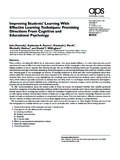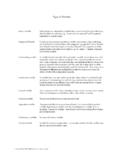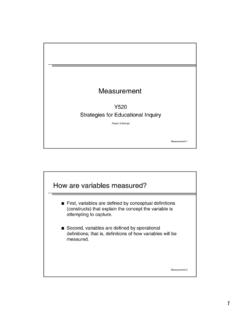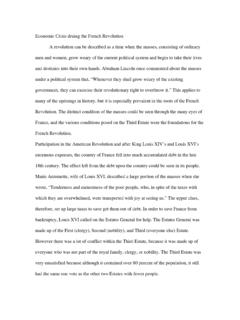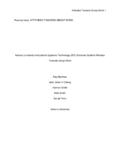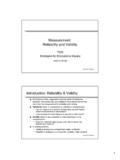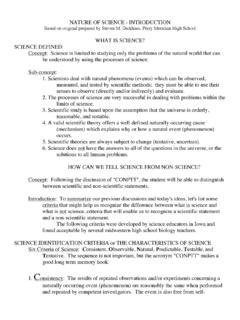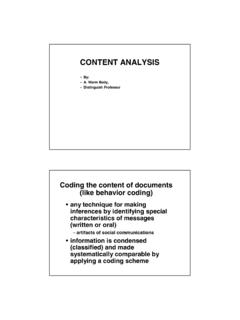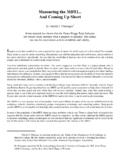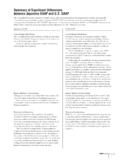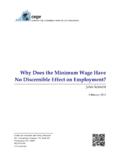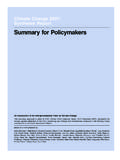Transcription of Hypothesis Testing Summary - Indiana University …
1 C:\rsm\y520\sec5982_fall02\week_12\ Testing Summary Hypothesis Testing begins with the drawing of a sample and calculating its characteristics (aka, statistics ). A statistical test (a specific form of a Hypothesis test) is an inferential pro-cess, based on probability, and is used to draw conclusions about the population parame-ters. One way to clarity the process of Hypothesis Testing is to imagine that you have first of all, a population to which no treatment has been applied (aka, comparison group ). You know the parameters of this population (for example, the mean and standard deviation). Another population exists that is the same as the first, except that some treatment has been applied (aka, the treatment or experimental group).
2 You do not know the parameters of this are drawn from this latter population and the statistics derived from the sample serve as the estimates of the unknown population parameters. This is the situation in which Hypothesis Testing applies, and it provides an introduction for understanding more compli-cated versions of Hypothesis Testing that you will encounter later. The logic of Hypothesis Testing can be stated in three steps:1 A Hypothesis concerning a population is A sample is selected from the The sample data are used to determine whether the Hypothesis can reasonably be supported or not.
3 Ultimately, the conclusion drawn is about the population not just the of this is necessary if the entire population is small and accessible, but this is almost never the 1: HOStep 1 breaks down into a series of formal stages. The first stage is to state the null hy pothe-sis, which is usually the Hypothesis of no difference. The null Hypothesis states that the treat-ment has no effect, or, stated differently, there is no difference between treated and untreated populations ( , 1 2 = 0). That is, the independent variable or treatment will have no effect on the dependent variable. The null Hypothesis is represented by the symbol Ho.
4 Examples of several forms that the null Hypothesis can take are contained in the following table:H0:ExplanationA. = 100 Population mean is = 0 Population mean is = 15 Standard deviation in the population is 1 2 = 0 Means of populations 1 and 2 are equal no difference in the parameters 1 and 2 E. 1 2 2 2 = 0 Variance in population 1 is equal to variance in population XY = 0 Correlation coefficient between x and y in the population is :\rsm\y520\sec5982_fall02\week_12\ 1: HAThe second stage is to state the alternative Hypothesis . It proposes the opposite of the null Hypothesis in that it says there will be an effect of treatment, there will be differences between populations, or that the independent variable or treatment does indeed affect the dependent variable.
5 The symbol for the alternative Hypothesis is either HA or H1 . Most often the HA is non-directional it just says there will be a difference without saying in which direction. Sometimes a directional Hypothesis is used. This will be discussed a little 2: SamplingStep 2 requires that a suitable sample is selected from the population. In order to adequately represent the population, the sample must be random. See sections through of Hop-kins, Hopkins, & Glass (1996) if you have problems with this 3: Statistical TestIn Step 3 the data from the sample are compared with the statement of the null Hypothesis .
6 For example, the sample mean (representing the mean of the unknown population) is com-pared with the known population mean. The decision is made whether or not to reject the null Hypothesis . See the discussion in section in HH&G for the reasoning behind deal-ing only with failure to accept the null we fail to accept null Hypothesis , we accept the alternative Hypothesis and conclude that there is a treatment effect or a difference between populations, that is, that the independent variable or treatment has affected the dependent steps are restated in the following table: G. 1 2 = 0 The difference between XY in population 1 and XY in pop-ulation 2 is 1 = 2 = 3 The means in populations 1, 2, and 3 are =.
7 5 The proportion in the population the statistical Hypothesis H0 to be tested ( , H0: = 100) the level of statistical significance (alpha level). That is, specify the degree of risk of a Type I error the risk of incorrectly concluding that H0 is false when indeed it is true. This risk, stated as a probability, is denoted by (alpha) and is the probability of a type I error ( , =.05). H0 to be correct, determine the probability (p) of obtaining a sample mean (X) that differs from the population mean ( ) by an amount as large or larger than that which was observed ( , if = 100, and X = 108, calculate the probability of observing a difference between X and of 8 or more points).
8 A decision regarding H0 whether or not to reject it ( , if the probability (p) from Step 3 is less than alpha (Step 2), we fail to accpet the null Hypothesis and conclude that mu does not equal :\rsm\y520\sec5982_fall02\week_12\ we make a decision about rejecting or failing to reject the null Hypothesis , two types of error may occur: We reject the null Hypothesis when we should not because in reality the null Hypothesis is true. This is known Type I, or alpha error. We accept the null Hypothesis when we should not because in reality the null Hypothesis is false. This decision is known as Type II, or beta error.)
9 The four outcomes of decision making are illustrated in the following box:Most experimenters hope to reject the null Hypothesis and to therefore claim that their experimental treatment has had an effect. However, as false claims of treatment effects (Type I errors) are scientifically serious, it is necessary to set stringent criteria. We can never be absolutely certain that we have correctly rejected, or failed to reject, the null Hypothesis , but we can determine the probability associated with making an error in this may recall from a previous lecture and textbook readings that the probability of obtain-ing a particular sample mean from a population can be determined using z-scores.
10 Sample means very close to the population mean are highly likely. Sample means distant from the population mean (in the tails of the distribution) are very unlikely, but they do occur. If the null Hypothesis is true and our treatment has no effect, we would expect that the sample we draw will have a mean close to that of the population. Sample means in the tails are not very likely if the null Hypothesis is true. Such means indicate that we should reject the null Hypothesis . (See Figure , p. 175, HH&G). A boundary or decision line has to be drawn, therefore, between those sample means that are expected, given the null Hypothesis , and those that are so unlikely that they lead to rejection of the null Hypothesis .
